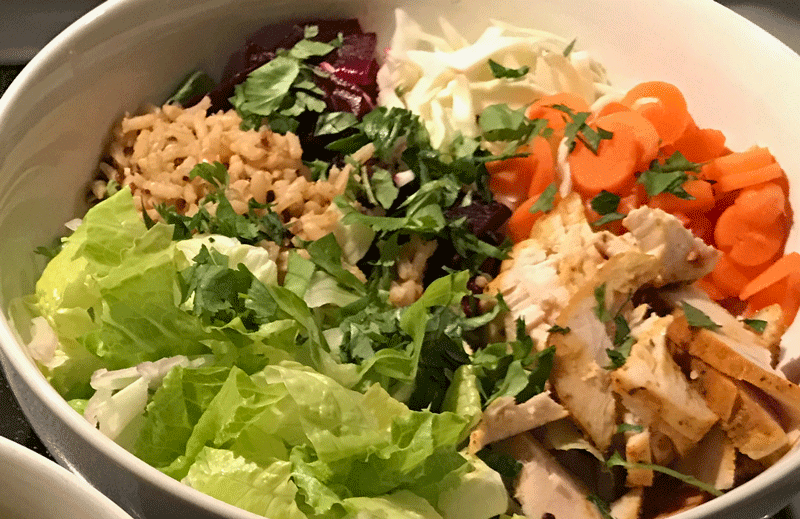Bone broth is excellent for making soups, stews, sauces, and sautés. If you are on a paleo or AIP diet, bone broth is often recommended for sipping in between meals for extra nutrition.
Category: Resources
How to make “Bowls”
“Bowls” are a newly popular concept, and for good reason. They are fresh, generally quick to put together, tasty, and relatively inexpensive.
Think Chipotle, SweetGreen, or pretty much any of the “healthy fast food” franchises popping up in malls across the country. Essentially it’s a pile of stuff in a bowl, with lettuce/greens on the bottom, and stuff on the top. Hm… sounds kind of familiar, right? Like a salad bar? Yep, exactly like a salad bar. The difference is in the marketing, and the proportions. it’s a little bit of salad with a lot of “stuff” arranged in a colorfully pretty selection of “wedges” around the edge.
Literally, it’s just a bowl of different wholesome, nicely flavored ingredients, that you then pour some sauce on and mix together, like… well… like a salad. Yeah.
Freezing Rice and Other Grains
Ever make more rice than you can eat? If you aren’t going to use it in the next few days, you can freeze it for later use. Here’s how:
- Put 1-1/2 to 2 cups of plain cooked (cooled) brown rice in a quart-size, freezer-grade ziplock bag. Don’t seal it shut yet.
- Flatten the bag out, then gently roll from the bottom up to remove as much air as possible, and zip closed.
- Flatten it back out and freeze flat.
To thaw, simply massage the bag briefly to break up the frozen rice, then empty it into a microwave safe bowl, cover with a paper towel, and microwave for 30 seconds or so (depending on the wattage of your microwave).
This works for most other cooked whole grains as well. I used to buy frozen pre-cooked brown rice at Trader Joe’s, but this is more economical and tastes fresher.
How to Cook Whole Grains
Barley
Barley is available pearled (the bran has been removed) or quick cooking (parboiled). Technically neither are whole grains but nutritionally speaking they count toward your whole-grain servings because of their high fiber content.
To Cook: Pearl barley Continue reading “How to Cook Whole Grains”
Slow Cooker Alternative
Want to make a slow cooker recipe but you don’t have the right equipment? Check out this great post from Stack Exchange on how to achieve the same great taste without the slow cooker.
https://cooking.stackexchange.com/questions/488/slow-cooking-without-a-slow-cooker
Is Canola Oil Really Healthy? Maybe not so much.
Canola oil has been touted for years as a healthy alternative to vegetable and peanut oils. But wait, not so fast. Canola oil is extracted from rapeseeds that have been altered through breeding to remove a substance called erucic acid, which was found to be harmful to rats. Most of today’s canola oil is produced from genetically modified rapeseeds owned by the mega-chemical company Monsanto. It is also heavily processed using chemicals. Watch the 5-minute video below to see how canola oil is made.
Obviously everyone has to make their own minds up, but IMO grapeseed oil is a better choice if you’re looking for a neutral-flavored cooking oil. First, I steer clear of genetically modified foods, mainly as a boycott of Monsanto products but also because with so many non-GMO alternatives readily available, why would I not choose the real deal instead? Second, as a healthy choice I avoid processed foods and this is one of the most highly processed ingredients you can buy.
I’d love to hear what you think in the comments below.


